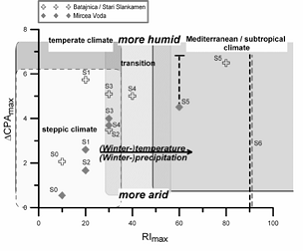LOESSFEST'09 | Aug. 31st – Sept. 3rd, 2009 |Novi Sad-Serbia
Paleoclimatic Trends in Southeastern Europe: Evidence From Soil Color and Geochemical Records in Loess Paleosol Sequences
Buggle, B.1, Glaser, B.1, Zöller, L.2, Hambach, U.2, Marković, S.B.3
1Department of Soil Physics, University of Bayreuth, Universitätsstr. 30, D-95440 Bayreuth, Germany
2Chair of Geomorphology, University of Bayreuth, Universitätsstr. 30, D-95440 Bayreuth, Germany
3Chair of Physical Geography, Faculty of Sciences, University of Novi Sad, Serbia.
Introduction
In the middle and lower Danube Basin, loess paleosol sequences (LPSS) of several decameter thickness are widely distributed. They provide valuable long-term archives for the Quaternary climate development of the region and possibly for SE- and Central Europe, in general. In the following, we develop a chronostratigraphy for two key sections of the area and derive first paleoclimatic information from the paleosols of the profiles by applying a soil color index of rubification and a geochemical proxy of mineral weathering. The presented results are a summary of two studies, published in Quaternary international (Buggle et al., 2009; QI, Vol. 196, pp. 86-106) and submitted to Quaternary Science Reviews.
Material /Methods
As key sections of the Vojvodina (southern part of the Pannonian Basin) and the lower Danube Basin / Dobrudja loess plateau, we investigated the loess paleosol sequences (LPSS) Batajnica / Stari Slankamen (Serbia; 44° 55´ 29´´ N, 20° 19´ 11´´ E and 45° 7´ 58´´ N, 20°18´ 44´´ E) and Mircea Voda (Romania, 44° 19´ 15´´ N, 28° 11´ 21´´ E). Each sequence contains at least six interglacial pedocomplexes, which were studied for soil color, magnetic susceptibility and element composition. A chronostratigraphy of the section was developed on basis of pedostratigraphic marker horizons and by correlating characteristic pattern of the magnetic susceptibility curve with the astronomically tuned records of the Chinese Loess Plateau and a marine δ18O proxy record for the global ice volume.
To derive paleoclimatic information from the profiles, the rubification intensity (RI) as proxy of the hematite content was quantified using the rubification index according to Harden (1982). As geochemical proxy for silicate weathering, we applied the Chemical Proxy of Alteration (CPA) – also known as CIW` - i.e. the molar ratio Al2O3/(Al2O3+ Na2O)*100. The CPA was evaluated against commonly used weathering indices as the CIA (Chemical Index of Alteration), CIW (Chemical Index of Weathering), the PIA (Plagioclase Index of Alteration), the Index B, and the Ba/Sr and Rb/Sr ratio. The CPA was found to be the most reliable weathering index for most LPSS, since biases due to calcium carbonate are minimized. Paleoclimatic interpretations were deduced from the ΔCPA characterizing the weathering enhancement between each pedocomplex and the underlying loess.
Results / Conclusion
Stratigraphy
We can show that the studied part of the sections comprises
the last 17 MIS stages (~700 ka). In even lower
parts of the Stari Slankamen section, earlier investigations
(Marković et al., 2004) identified also the Brunhes-
Matuyama (B/M) boundary in a similar stratigraphic
position as in Chinese LPSS.
Besides the B/M boundary in Stari Slankamen, our chronostratigraphic model is also supported by IRSL dates and the amino acid racemization chronology of the respective pedostratigraphic units in nearby sections (e.g. Fuchs et al., 2008; Marković et al., 2006).

Figure 1. ΔCPAmax vs. RImax plot. The steppe climate field
comprises (fossil) steppe soils having soil colors (wet) of 10
YR, whereas the Mediterranean/subtropical climate field
contains paleosols which meet the WRB /FAO requirements
for the chromic qualifier. Overlapping with both, we defined
a transition zone that incorporates weakly to moderately
rubified fossil, degraded steppe soils and fossil Cambisols.
We interpret the transition from the steppe climate field
to the Mediterranean / subtropic climate field mainly as a
function of (winter-) temperature and (winter-) precipitation.,
since higher winter temperatures and – precipitation
promote degradation of organic material. High contents of
organic material hampers hematite formation under the
present (steppic) type of climate. Variations of the ΔCPAmax
at a given temperature regime i.e. in about the same range
of RImax are considered as a function of humidity . Thus, for
the case of high ΔCPAmax values together with low RImax
values we assigned a humid, temperate climate field, being
to wet for the formation of steppe soils. Dashed, bold lines
in the diagram indicate uncertainty ranges of the ΔCPAmax,
since the CPA values of the parent loess unit for the Mircea
Voda S5 may be biased by pedogenetic overprint and for the
S6 no data at all were available to derive background CPA
values.
Paleoclimatic interpretation
The maximum RI (RImax) and ΔCPA values (ΔCPAmax)
obtained for each interglacial pedocomplex are presented
in figure 1. For both, the Serbian and Romanian
LPSS, an increase of the rubification intensity to the
older pedocomplexes is indicated. This is in line with
our field observations, in which the younger pedocomplexes
S1 to S3 have been identified as fossil steppe soils.
In figure 1 we present also a model of how a combination
of a silicate weathering proxy(ΔCPA) and a proxy of
hematite formation (RImax) could provide paleoclimatic
information, also with respect to seasonality.
For the middle and lower Danube Basin our results confirm a transition from a Mediterranean-type of climate during the warm stages of MIS 13-15 and MIS 17 to cooler and dryer steppe climate conditions during the younger warm stages. The climate deterioration occurred gradually from one interglacial to the other. The essential changeover between the two different climate systems appeared between MIS 13-15 and MIS 9. There is no evidence that regional climatic trends i.e. higher aridity at the Romanian site, were significantly different from today.



